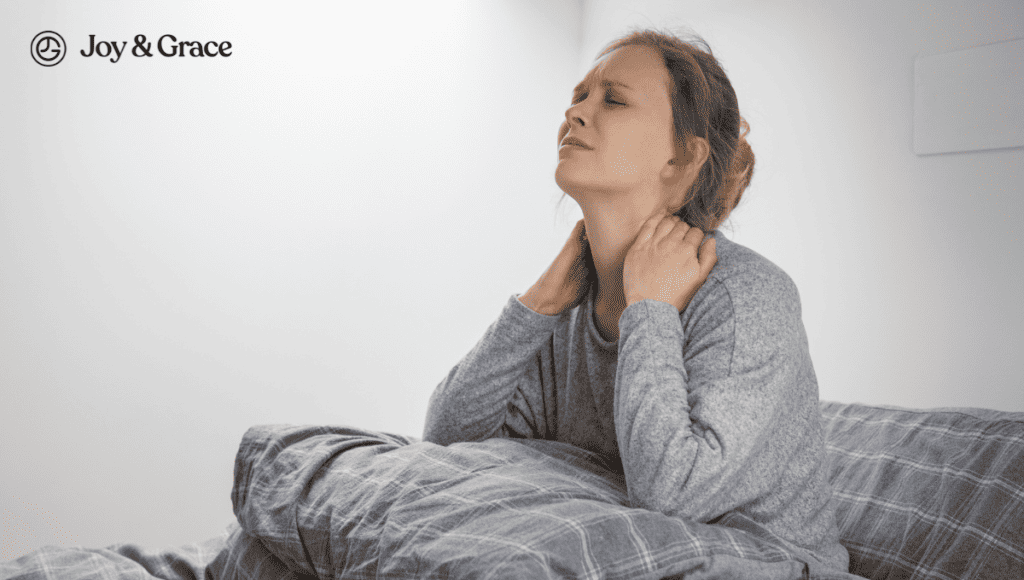Your neck, or cervical spine, is a complex structure made up of seven small vertebrae. It starts from the base of the skull and continues down the spine. It has the hefty task of supporting the head, weighing up to 15 pounds. Not only does it support the head, but it also provides flexibility and movement.
However, this intricate structure can be susceptible to conditions that can cause pain.
Join us as we unpack neck and spine pain.
Why Do My Neck Vertebrae Hurt?
Most often, the vertebrae in our neck do not truly hurt themselves. What we typically feel are the layers above them, like muscles and tendons. When vertebrae themselves do cause pain, it's usually due to direct injuries.
As a result, we will use "vertebral pain" and "neck pain" to refer to the same thing in this article.
With that in mind, posterior neck pain (where the vertebrae are located) often results from the natural process of aging, accidents, or even daily activities that may strain the neck. Yes, this includes long periods of looking down at your smartphone. In older individuals, degenerative disorders are the usual culprits for cervical spine pain.
In general, cervical spine pain is often due to the following conditions:
- Poor Posture
Poor posture is a common cause of neck pain, particularly in today's sedentary lifestyle. Due to the popularity of technology, slouching or hunching over can be the default posture for some. The added stress on the cervical spine can misalign the cervical spine, resulting in chronic neck pain.
Maintaining these positions can also strain the neck muscles, leading us to our next point. - Muscle Strain
Muscle strain can directly impact the neck and contribute to pain. Tension in the neck muscles can result from:- Overexertion,
- Repetitive movements
- Sudden, jerky movement
Muscle strength may diminish in older individuals, making them more susceptible to strain and fatigue. Additionally, age-related changes in muscle elasticity and recovery can prolong the effects of strain. This can result in persistent neck pain.
- Osteoarthritis
Osteoarthritis is a degenerative joint disease often associated with aging. It can contribute to neck pain by affecting the joints of the cervical spine. The protective cartilage cushioning the vertebrae in the neck may wear down over time, leading to bone-on-bone friction. - Trauma
Trauma from a sudden injury or repetitive stress can significantly impact the vertebrae of the neck, causing pain. Injuries like whiplash can also strain the neck muscles, leading to persistent neck pain.
In older individuals, the effects of past injuries may be more noticeable. Furthermore, the natural degeneration of tissues can worsen the pain and delay recovery. - Cervical Spondylosis
Cervical spondylosis is the degeneration of the spinal discs and joints in the neck. Like osteoarthritis, it’s often associated with aging. Our spinal discs may lose water content and elasticity as we age, reducing cushioning between the vertebrae.
This degeneration can result in the formation of bone spurs and the compression of nerves, causing neck pain. It can also result in two conditions:
-
- Herniated disc
A herniated disc occurs when a spinal disc's soft, gel-like center pushes through a tear in the tough outer layer. This can result in pressure on nearby nerves, leading to pain, numbness, or weakness in the back or limbs.
Cervical stenosis is the narrowing of the spinal canal in the neck. This narrowing can put pressure on the spinal cord and nerves. This results in symptoms such as neck pain, numbness, or weakness in the arms or hands.
It’s important to note that these conditions are not limited to your neck. They can also affect the rest of the spine, causing upper or lower back pain.
Can Stress Cause Cervical Spine Pain?
Absolutely, stress and mood disorders can be factors in the development of neck pain. Stress can cause your neck muscles to be in a constant state of contraction. This ongoing tension can contribute to aches in the neck vertebrae. And it doesn’t stop there. It can contribute to pain in your back and shoulders, too.
But what's the connection between stress and neck pain?
Well stress triggers the release of cortisol. Cortisol is the hormone responsible for your “fight or flight” response. This hormone causes your muscles to tense up for protection.
And it gets more complicated.
Stress can affect pain in two ways. During acute or short-term stress, your body actually suppresses pain (analgesia). This allows you to escape or cope with the stress.
While this might seem beneficial at first, we often end up experiencing aches and pains later on once the immediate stress has passed.
On the other hand, in some individuals, a different reaction known as hyperalgesia may occur.
Hyperalgesia is characterized by an increased sensitivity to pain, where even mild physical discomfort can be felt more intensely.
The bottom line is that excessive stress can definitely hurt our necks, and it does so through various mechanisms.
What Does Neck Spine Pain Feel Like?
This can be a bit tricky, as your neck muscles and spine are intertwined, and their symptoms can overlap, as we mentioned earlier.
Pain from the neck bones is often deep and centralized in the neck. Hence, it’s usually described as a dull ache or throbbing. However, if a nerve is compressed, you might also have sharp or shooting pain.
On the other hand, neck pain from muscle strains can be more superficial and is more likely to spread along the length of the muscle. If you have a strained neck muscle, it might feel tight or sore. But as mentioned, both types of pain can overlap.
In conclusion, the feeling of neck and spine pain can be highly subjective and depends on the underlying cause and your pain tolerance. What remains consistent, though, is that neck and spine pain can significantly impact your daily life.
What Are the Symptoms of Neck Spine Problems?
Aside from neck pain, cervical spine problems can cause:
- Shoulder pain
- Upper back pain
- A stiff neck
- Weakness
- Tingling
- Numbness
- Burning
In severe cases, you might have:
- Problems with balance and coordination
- Difficulty gripping or lifting objects
- Changes in urination or bowel control
How Do I Relieve Neck Vertebral Pain?
So, how do you relieve this type of pain? Luckily, there are solutions you can easily do at home to help relieve your neck pain. These include:
- Rest and Activity Modification
Rest may be recommended initially to allow the injured or strained tissues to heal. Avoid physical activities that worsen the pain or strain the neck muscles. - Gentle exercise and stretching
Gentle stretching exercises can help alleviate neck and spine pain. They can also help strengthen the neck, preventing the pain from reoccurring. Remember to always start gently and gradually increase the intensity. - Heat and Cold Therapy
Another method for relief is applying heat or cold to the affected area. A warm shower or heating pad can help soothe stiff muscles. Meanwhile, a cold pack can reduce inflammation. - Proper posture and ergonomics
With the prevalence of technology, our necks often suffer due to poor posture. Along these lines, adjusting your daily habits to promote better posture can help manage the pain. This includes setting up an ergonomic workspace and taking regular breaks. - Over-the-counter pain medication
Lastly, over-the-counter pain relievers like acetaminophen can provide temporary relief. However, it's important to use them safely and as directed to avoid possible side effects or health risks.
Is Walking Good for Cervical Spine Pain?
Walking can indeed be a beneficial exercise for cervical spine pain.
According to a study, increasing your daily steps by 1,000 reduces the risk of neck pain by 14%. So don’t forget to get up from your desk and take short walks.
Additionally, walking is a low-impact workout, meaning it's gentle on your joints, including those in your cervical spine. This makes it suitable for people of all ages, including older adults experiencing neck pain in old age. But take note: you should be walking the right way, as an improper strut can, in fact, cause or worsen neck pain.
Keep in mind that the benefits of walking go beyond the physical. Engaging in regular walks can enhance mental well-being, too. It tends to lower stress and anxiety levels, which, in turn, can indirectly reduce neck pain.
Is Cervical Spine Pain Curable?
Cervical spine pain is often treatable and manageable. However, it depends on the exact cause and the severity. Many cases of cervical spine pain improve with conservative measures.
However, there are instances when cervical spine pain may not be entirely curable. Conditions like degenerative disc disease or severe injuries may lead to chronic pain that persists despite treatment.
Additionally, certain medical conditions or structural abnormalities may limit the effectiveness of interventions. In such cases, the goal shifts from a complete cure to improving your quality of life and managing symptoms.
This is why it’s important to consult with a healthcare professional. A proper evaluation allows you to receive a treatment plan tailored to your specific condition.
How Is Neck Pain Managed or Treated?
Here are some general strategies commonly used to manage cervical spine pain:
- Physical Therapy
Physical therapy can help improve neck strength, flexibility, and posture. Physical therapists may use exercises and manual techniques to address pain and improve function. - Pain Medications
Aside from the OTC painkillers mentioned earlier, your doctor can also prescribe you stronger pain medications. This depends on the severity of your condition. This can include:- Corticosteroids
- Opioids – these are often the last resort and are given for only a short amount of time due to their serious side effects.
- Muscle relaxants
- Cervical Collars
Sometimes, a soft cervical collar may be prescribed to support and restrict movement. These are often used during the initial stages of recovery. - Cervical Traction
This involves gently stretching the neck to relieve pressure on the spine and reduce pain. It's typically done under the guidance of a healthcare professional. - Corticosteroid Injections
Corticosteroid injections may be considered for more severe pain and inflammation. These injections are administered directly into the affected area of the spine. - Surgery
In cases of severe and persistent pain that does not respond to conservative treatments, surgery may be considered. This is typically reserved for specific conditions, such as:- Herniated discs
- Spinal stenosis
- Other structural abnormalities
How Can I Prevent Neck Spine Pain?
We’ve already mentioned some preventive measures earlier, but here’s a quick recap:
- Rest and taking breaks
- Observing proper posture
- Gentle stretches and regular exercise
- Proper ergonomics
Aside from these, the following can also help prevent neck pain:
- Sleep position
If you sleep on your back, use a rounded pillow to support the natural curve of your neck.
Even when you’re sleeping on your side, keep your spine aligned. And if you’re wondering, sleeping on your stomach is not good for your neck. - Get proper nutrition and maintain a healthy weight
Maintaining a healthy weight helps reduce strain on your neck and spine, which can help prevent pain.
Eating foods with anti-inflammatory properties, such as vegetables and fish high in omega-3s, can also help.
Also, remember to hydrate, as water is essential for maintaining the resiliency of your spinal discs.
Whether you’re young or more seasoned, implementing these simple strategies in your daily life can help you effectively manage and prevent neck pain.
How Can I Strengthen My Cervical Spine?
It’s important to note that neck-strengthening exercises are not for everyone. It’s important to consult a healthcare professional regarding your condition before performing any exercise.
With that said, here are some exercises to try:
- Start by lying on your back with your head in a neutral position.
- Place your fingers on your chin, ensuring a gentle but firm grip.
- Slowly and smoothly push downward on your chin, allowing your head to tuck in towards your chest.
- Focus on feeling a stretch in the back of your neck during the movement.
- Repeat the movement 8–10 times, maintaining a controlled pace.
- While performing the exercise, monitor any sensations of pain. Pay attention to whether there is an improvement or worsening of your pain.
- If you experience worsening pain due to the exercise, stop immediately.
- If you notice improvement, you can continue with the recommended repetitions.
- Choose a comfortable sitting or standing position with your spine straight.
- Place your fingers on the front of your chin.
- Push your head backward as far as possible, well past the "neutral" position.
- While doing this, make sure you don’t tuck your chin or face.
- As you push your head backward, you will feel a stretch in the back of your neck.
- Hold the position for 1-2 seconds.
- Gradually return your head to the starting position.
- Repeat this 8–10 times at a controlled pace.
- Perform 3–4 sessions of this exercise daily, especially if you experience pain relief.
- Even after pain is eliminated, continue performing this exercise 3–4 times daily for an additional two weeks to help prevent the pain from recurring.
- Start with your neck in a neutral position and your head facing forward.
- Gradually turn your head to one side, allowing your neck to stretch gently.
- Hold the stretched position for 2 seconds, feeling the stretch on the opposite side of your neck.
- Slowly return your head to the starting position.
- Repeat the same sequence on the other side.
- Side Head Tilt
- Begin with your neck in a neutral position, head facing forward.
- Gradually tilt your head towards one shoulder until you feel a comfortable stretch on the opposite side.
- Hold the position for 2 seconds.
- Slowly return your head to the starting position.
- Repeat the tilting sequence on the other side.
How Long Is the Recovery for Cervical Spine Pain?
The recovery time for cervical spine pain can depend on the cause and treatment method.
For minor strains and sprains, you might be looking at a recovery period of a few days to a few weeks.
In contrast, if you're dealing with something more severe, like a herniated disc or cervical spondylosis, recovery may take several months with the aid of physical therapy or surgery.
Neck pain in seniors is often linked to degenerative disorders, which can cause chronic pain and slower recovery times.
Everyone's body responds differently to treatment, so it’s always advisable not to compare your recovery process to others.
When Should I Call the Doctor If I Have Neck Pain?
Knowing when to seek medical help for your neck pain can be challenging. People often try to tough it out, hoping it will go away on its own. But here's the thing: neck pain can sometimes be a sign of a more serious underlying condition.
Firstly, if your neck pain isn't improving after a few days of home treatment, it may be time to consult a professional.
Likewise, if the pain recurs regularly or if it's severe enough to interfere with your daily activities, that's another sign to dial up your healthcare provider.
Call your doctor if your neck pain comes with the following symptoms:
- Weakness
- Numbness
- Tingling
- Issues with your coordination or balance
These could indicate neurological problems due to compression on the exiting spinal nerve roots or the spinal cord.
Additionally, it is crucial to seek immediate medical attention if a neck injury—a fall, a car accident, or any other type of trauma—caused your pain. Injuries can lead to more complicated issues, including fractures or spinal cord damage.
Lastly, let's talk about pain in the back of the neck (your nape). Pain in this area may be a symptom of conditions like meningitis or tumors when combined with the following symptoms:
- Headache
- Fatigue
- Fever
- Rash
- Unexplained weight loss
- Sensitivity to light (photophobia)
Remember, it's better to be safe. Your health isn't something you should gamble with. When in doubt, pick up the phone and talk to a medical professional.
Takeaway
Neck pain is a common complaint that can seriously impact your quality of life. It can spring up due to the various structures in your neck, commonly the muscles or vertebrae.
When discussing “spine pain in the neck,” we're considering the seven vertebrae that make up the cervical spine or neck. These vertebrae have a heavy workload, supporting the weight of the head. It's not surprising, then, that issues can arise.
Remember, neck pain is not something you just have to live with. Identifying the exact cause can allow you to receive proper management and find relief.















